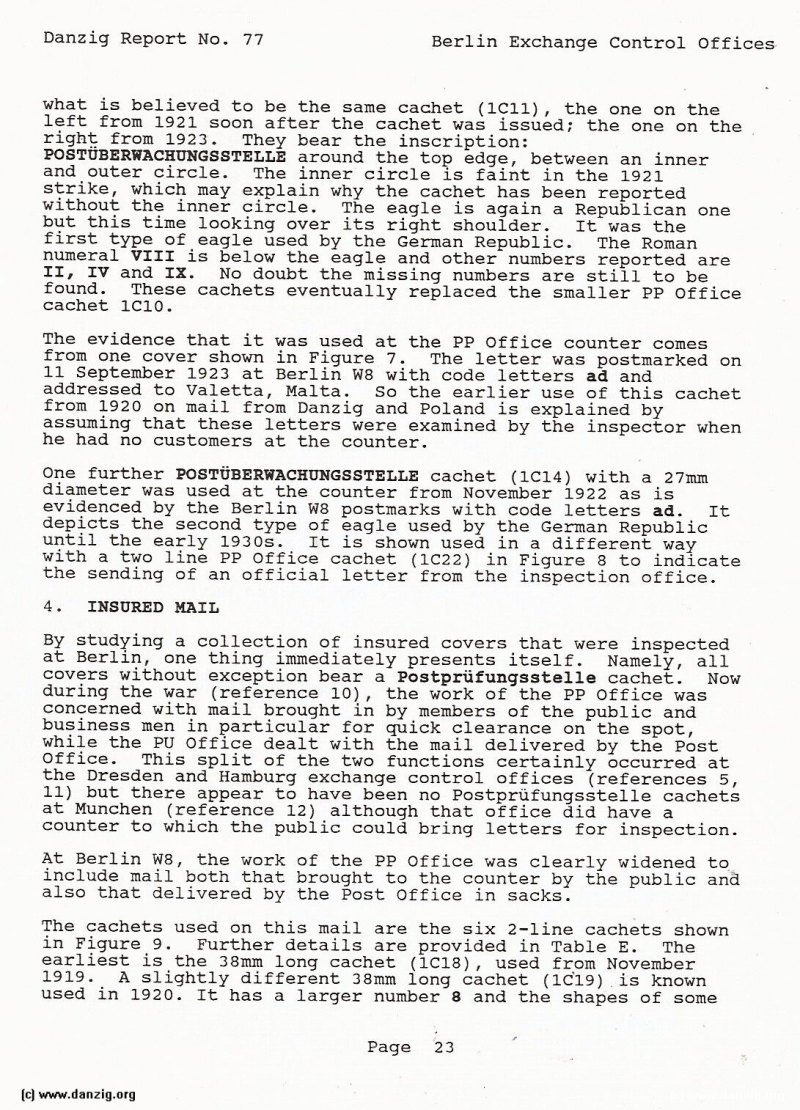
what is believed to be the same cachet (1C11), the one on the left from 1921 soon after the cachet was issued; the one on the right from 1923. They bear the inscription:
POSTUBERWACHUNGSSTELLE around the top edge, between an inner and outer circle. The inner circle is faint in the 1921 strike, which may explain why the cachet has been reported without the inner circle. The eagle is again a Republican one but this time looking over its right shoulder. It was the first type of eagle used by the German Republic. The Roman numeral VIII is below the eagle and other numbers reported are II, IV and IX. No doubt the missing numbers are still to be found. These cachets eventually replaced the smaller PP Office cachet 1C1O.
The evidence that it was used at the PP Office counter comes from one cover shown in Figure 7. The letter was postmarked on 11 September 1923 at Berlin W8 with code letters ad and addressed to Valetta, Malta. So the earlier use of this cachet from 1920 on mail from Danzig and Poland is explained by assuming that these letters were examined by the inspector when he had no customers at the counter.
One further POSTUBERWACrnJNGSSTELLE cachet (1C14) with a 27mm diameter was used at the counter from November 1922 as is evidenced by the Berlin W8 postmarks with code letters ad. It depicts the second type of eagle used by the German Republic until the early 1930s. It is shown used in a different way with a two line PP Office cachet (1C22) in Figure 8 to indicate the sending of an official letter from the inspection office.
4. INSURED MAIL
By studying a collection of insured covers that were inspected at Berlin, one thing immediately presents itself. Namely, all covers without exception bear a Postprufungsstelle cachet. Now during the war (reference 10), the work of the PP Office was concerned with mail brought in by members of the public and business men in particular for quick clearance on the spot, while the PU Office dealt with the mail delivered by the Post Office. This split of the two functions certainly occurred at the Dresden and Hamburg exchange control offices (references 5, 11) but there appear to have been no Postprüfungsstelle cachets at Munchen (reference 12) although that office did have a counter to which the public could bring letters for inspection.
At Berlin W8, the work of the PP Office was clearly widened to include mail both that brought to the counter by the public and also that delivered by the Post Office in sacks.
The cachets used on this mail are the six 2—line cachets shown in Figure 9. Further details are provided in Table E. The earliest is the 38mm long cachet (lCl8), used from November 1919. A slightly different 38mm long cachet (1C19) is known used in 1920. It has a larger number 8 and the shapes of some
Danzig Report Vol. 1 - Nr. 77 - October - November - December - 1992, Page 23.
Hits: 3503
Added: 03/07/2015
Copyright: 2025 Danzig.org

